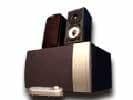
Edifier S2.1D
Ease of Set Up
Ease of Use
Sound Quality
Edifier S2.1D
When you purchase through links on our site, we may earn an affiliate commission. Here's how it works.

User Reviews
Value For Money
Ease of Use
Ease of Set Up
Sound Quality
Overall This Speaker Is Not A Bad One Considering
Overall this speaker is not a bad one considering from its price.
Value For Money
All Around The Retail Box Were All Chinese Words,
All around the retail box were all Chinese words, and a small stuck-on label were the only English words I could find. Even though Edifier is a Chinese company, don't let the country of origin give you prejudice on the quality of these S2.1D speakers. As I opened the box, I was greeted by a S/PDIF optical cable, two satellites with removable cloth grills built on medium density fibre (MDF), and a sub-woofer amplifier unit. Also in the box was a wired remote, two pair of cables for the satellites, and a 35mm stereo minijack to co-ax interconnect.
Setting-up was effortless. The satellite cables came stripped and tinned at each end, which made it easy for the spring clips on the satellite to hold on to it. The remote was wired using a mini-DIN plug (much like the PS/2 connector), and I used the analog interconnects.
The satellites are very solid and relatively heavy for what I would expect for multimedia speakers. The satellites themselves are 2-way units with a 3/4" silk dome tweeter and 3" mid-range, set nicely into hexagonal MDF housing, complete with two metal pins on the front to tilt the satellites upwards and removable cloth grille. At the back, you will find the two spring clips and a hole to facilitate wall-hanging.
The sub-woofer utilizes a 6.5" long throw bass driver, with a port at the back. The manufacturer's specs claim usage of toroidial transformers and dual-cavity design. The sub's grille is also removable. The connectors behind include co-ax analog input, both digital inputs mentioned earlier, remote socket, and satellite output. The AC cable is tethered, with a plastic On/Off switch.
The remote comes in as a clumsy and badly-designed plastic unit. At least the knob felt solid, but the power/function selector button came in rather stiff. Functions available on the remote includes power, main volume, LFE (bass), treble, loudness (bass boost), and balance. Setting position is indicated with 7 LEDs around the main knob. For this review, I will refer to the 4th LED as indicating zero (0) or neutral.
After warming in the set for 48 hours, I ran a test on it with my usual material. I found that the sub/satellite crossover begins around 80Hz and completes at 150Hz. Frequency response was rather linear across the spectrum, without the usual drop in volume at the crossover frequency. The speakers start responding at 30Hz, and I could not detect anymore sound beyond 19KHz. At the claimed 80 watts of power output, it delivered enough sound pressure to receive complaints from my neighbours.
With my musical content, I found the bass to be overwhelming with LFE setting at 0, so I had to put it to -1 (with -3 being maximum bass suppresion), and loudness to the off position. Vocal content from Diana Krall and Sophie Bextor came out distinct, sultry and smooth. More complex sounds from *NSYNC and Christina Aguilera revealed full details, while orchestral pieces like Strauss' Emperor Waltz revealed little if any dynamic compression. Every instrument came out well. Stereo soundstaging was superb, with very crisp high-ends and clean and sharp low-ends.
Due to the upper bass being played by the 3" mid-range as well as the subwoofer, the upper bass stereo detail was also better.
With Unreal Tournament 2003, gaming sounded rather flat. Rather than tweaking the bass/treble settings, I found out that turning on the Loudness setting could easily switch the speakers from musicality to gaming/movie capabilities. The bass boost gave the game more oomph, and the explosions sounded full and boomy. Stereo positioning was also good, but of course will never replace a proper 4.1/5.1 gaming/DVD system. Turning on the loudness does make the lower mids muddy, and occasionally overdrives the 3" mid.
Considering that I paid USD105 for this set, it really gives the Altec 621 and Promedia2.1 a run for their money. For this review, I drew comparisons from my experiences with Altec's ATP3, ACS45.1, ACS43, Creative Inspire 5300, Labtec Pulse-424 and Promedia 2.1.
For pictures and manufacturer-claimed specs, please go to recommended URL
Q&A
There are no questions yet.